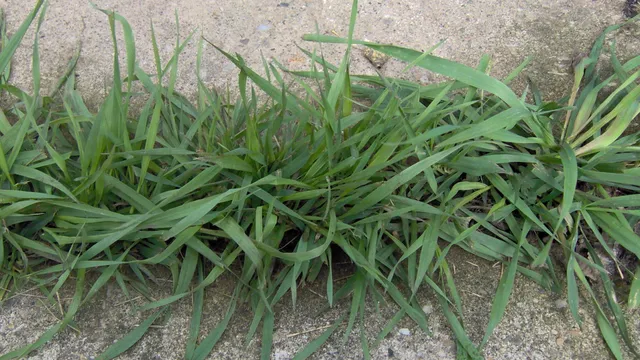While a lush green lawn may be every dad’s dream, achieving this dream comes with plenty of challenges. One of the biggest challenges to maintaining a beautiful lawn is managing weeds. Two of the most common lawn weeds that we encounter are crabgrass and quackgrass. While crabgrass and quackgrass may look similar, their control treatments vary greatly. Learning the difference between these grasses and how to treat each will help to save you both time and money.
Crabgrass

Crabgrass is an annual weed that thrives in hot sun and poor turf. Crabgrass is known for its thick, yellowish-green blades that make it stand out from the surrounding turfgrass. With a unique flat growth habit, crabgrass tends to grow outward rather than upward. This leads to the crabgrass usually being lower than your mower blades. Since crabgrass is an annual, it spreads by seed and dies off every year. Crabgrass seeds have to wait for the soil temperatures to warm up before they can germinate. Because of this, crabgrass tends to appear more in the very late spring to early summer. If you are seeing nuisance grass early in the spring, it is likely quackgrass or tall fescue, not crabgrass. To control crabgrass, spread a granular pre-emergent weed control in the early spring (mid-April through mid-May). The pre-emergent will prevent the new crabgrass seeds from germinating. If you seed your lawn in the spring, make sure that you do not put down crabgrass preventer until your grass seed has sprouted, as the pre-emergent will prevent your grass seed from germinating. If you already have crabgrass that has emerged, spot treat with a crabgrass killer. Crabgrass can also be hand-pulled as the root system tends to be shallow and the roots stay clumped together. Each crabgrass plant can produce 150,000 seeds, and these seeds can stay viable in the soil for years. It is important to try and control crabgrass as soon as you see it so that it does not have time to develop and spread its seeds.
Quackgrass

Quackgrass is a fast-growing, cool-season perennial that emerges in the early spring. Like crabgrass, quackgrass has wide grass-like blades, but quackgrass has a more upright, tall habit than crabgrass. Since quackgrass is a perennial, it comes back every year and spreads by both underground rhizomes as well as by seed. Quackgrass is a cool-season plant, which means that it will do most of its active growing in the cooler seasons (spring and fall), and you will likely see quackgrass begin to pop up in the early spring. Quackgrass can only be treated with herbicides that contain glyphosate, like Roundup. These products will also kill the surrounding grass, so plan to reseed areas that you treat for quackgrass. Because of the extensive root system of quackgrass, hand pulling is often time-consuming and may not be as effective as chemical herbicides. If you decide to hand-pull your quackgrass, try to get as much of the root system as possible, as any rhizome missed can grow into a new plant. It is important to try and treat quackgrass as soon as possible, as quackgrass is an aggressive weed that can quickly take over an area. Quackgrass rhizomes can also produce a chemical that stunts the growth of surrounding plants, allowing the quackgrass to outcompete turfgrass.
Tips
Quackgrass and crabgrass both thrive in weak or thin lawns, so promoting a healthy, thick lawn with a deep root system can help prevent or lessen issues with weeds. Below are a few tips on how to keep your lawn full and flourishing.
- Water properly: Industry experts recommend watering your lawn only once or twice a week. Both overwatering and underwatering can lead to weak lawns and can encourage the spreading of weeds.
- Mow at the correct height: Allowing your lawn to grow taller can help your lawn grow thicker and develop a stronger root system. Taller grass shades out weed seeds and keeps your soil temperatures cooler which decreases the chances of seeds germinating. Experts recommend keeping your lawn between 3” to 4” tall and removing no more than 1/3rd of the leaf tissue when you mow.
- Fertilizing: When used correctly, fertilizers can be an amazing tool to help you improve and maintain a lush lawn. Fertilizers are important as they supplement the soil with important nutrients that are often lost when clippings are removed when mowing. For lawns, look for a fertilizer with a higher concentration of nitrogen, as this is the nutrient that most lawns lack. To prevent burning, always make sure to follow the label directions and water after applying fertilizer (unless the label says otherwise).

